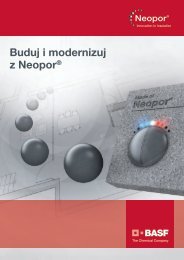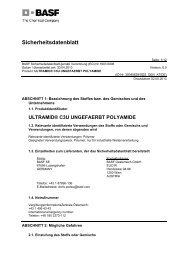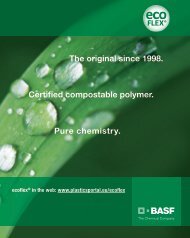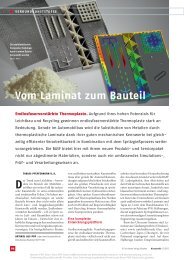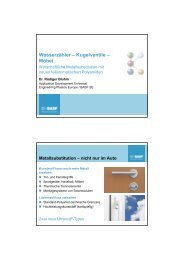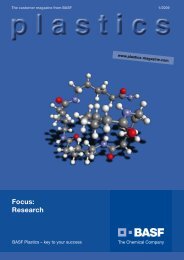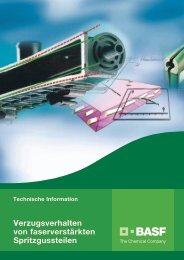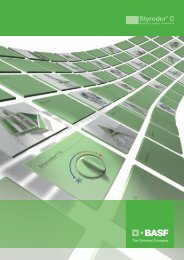plastics - The customer magazine from BASF 2/2007
plastics - The customer magazine from BASF 2/2007
plastics - The customer magazine from BASF 2/2007
You also want an ePaper? Increase the reach of your titles
YUMPU automatically turns print PDFs into web optimized ePapers that Google loves.
News<br />
Setting a new record<br />
Seven million tons of adipic acid<br />
Seven million tons of adipic acid – this<br />
record has now been set by <strong>BASF</strong>. <strong>The</strong><br />
product, which has been in production<br />
at <strong>BASF</strong> since 1939, leaves the factory<br />
either as a solution or in solid form. This<br />
classic product continues to sell as briskly<br />
as ever, “<strong>The</strong> demand for adipic acid is<br />
very high at the moment, so we have<br />
been producing well above average in recent<br />
months,” explains Thomas Jaworek,<br />
deputy operating manager.<br />
When large-scale production of adipic<br />
acid began in 1947, a mere two to three<br />
tons were being produced per day. In the<br />
decades that followed, <strong>BASF</strong> increased<br />
the capacity of the facility to meet the rising<br />
demand, up to today’s production of<br />
270,000 tons annually.<br />
Adipic acid is one of the two components<br />
that make up hexamethylene diamine adipate,<br />
a precursor of polyamide 6.6. <strong>The</strong><br />
major buyers are the clothing, footwear<br />
and automotive industries. One of the<br />
best-known final products made of this<br />
material is nylon stockings. Moreover, it is<br />
an intermediate in the production of polyurethane<br />
systems. This substance can<br />
Sports shoes made of polyurethane, a secondary<br />
product of adipic acid.<br />
be found in nature in sugar beets and red<br />
beets and it is used in the food industry<br />
as an acidifier in soft drinks.<br />
New compounding facility in Shanghai<br />
Expansion of production and development service<br />
for engineering <strong>plastics</strong> in Asia<br />
Opening ceremony of the new<br />
compounding facility in Shanghai.<br />
<strong>BASF</strong> has inaugurated one of the world’s<br />
most modern compounding facilities<br />
for engineering<br />
<strong>plastics</strong> at its<br />
Pudong site in<br />
Shanghai, China.<br />
This new worldscale<br />
installation<br />
with an annual<br />
capacity of 45,000<br />
tons has been<br />
operating successfully<br />
since March.<br />
It stands out for its<br />
efficient production<br />
process and very<br />
high environmental<br />
standards. This<br />
new installation<br />
boosts <strong>BASF</strong>’s compounding capacity<br />
in Asia to over 100,000 tons per year.<br />
Moreover, <strong>BASF</strong> has set up a development<br />
center for engineering <strong>plastics</strong><br />
in Shanghai, where engineers cooperate<br />
closely with <strong>customer</strong>s to create<br />
and optimize new applications. This<br />
collaboration ranges <strong>from</strong> computeraided<br />
design in the initial phase all<br />
the way to component testing during<br />
the experimental and market-ready<br />
stages. <strong>BASF</strong>’s state-of-the-art injection-molding<br />
technical laboratory also<br />
offers its <strong>customer</strong>s services in process<br />
technology. <strong>The</strong> technical center<br />
is part of a worldwide integrated<br />
research network that also encompasses<br />
centers in Japan and Korea, in<br />
Europe and in the United States.<br />
7



